Products You May Like
The opening theme of Mythforce is a wonderfully observed 1980s positivity ballad in the style of Jayce and The Wheeled Warriors. This song believes in you, aggressively so. “MythForce! MythForce! Everyday people become heroes! / MythForce! MythForce! You and me, we can defeat evil!” The roguelike dungeon dallying that follows doesn’t take that “you can do it!” Saturday morning cartoon flavour to its comedic conclusion in the same way an Adult Swim animation might, or a Devolver game would. Instead the real focus seems to be function over flavour, resulting in a skeleton-battering jaunt that is competent and comfortable, yet never fully embracing the silliness promised by the sick guitar riffs of the theme.
You (and your friends, if you have those) will play one of four finely chiseled heroes, all rendered through a bright cartoon filter – probably some of that fine shader magic we hear so much about. There’s an angry mace wielding knight with a Captain America-style shield flinging ability and a penchant for ground pounds. A ranged hunter who can ghost away from trouble and fire arrows that slurp every nearby enemy into a vortex. And a rogueish, um, rogue, whose abilities include a fistful of “pocket sand” you can throw in the eyes of approaching enemies before teleporting behind them for a fatal backstab.

The final character is a spellcaster called Maggie (imagine if Aliya Elasra from Heaven’s Vault got really into belts) who brings a combo of fireball yeeting and bubble-shield conjuring that is nice and distinct from the other characters, if a little slower on the damage-dealing side. For me, she’s the most interesting and challenging to play with (though she could probably do without shouting voice lines for every single heavy attack).
These characters look the part when it comes to the He-Man-inspired pastiche, but otherwise they don’t have the same colour when it comes to in-game voice lines or end-of-episode dialogue. Like I say, the focus of the marketing seems to be “relive your childhood!” but the game’s moving parts are all focused on making a dungeon-running co-op roguelike that conforms to player expectations. That’s not necessarily a bad thing, it just means that you quickly forget about the theme and get to pulverizing skellingtons, incinerating bosses, and hoovering up gold.
The procedurally generated crypts and courtyards are full of the stuff. Barfing out from chests and spilling out of smashed pots. The general loop is this: enter a room, do a lot of good murder, slurp up loot, claim a perk, move onto the next room. Alongside glittering currency you’ll also find ability-empowering orbs and wearable buffs, like a pair of shoes that nets you 20% more gold wherever it appears, or a risk-reward do-hickey that decreases fire damage while increasing ice damage. There are a bunch of classic roguelike gizmos that stack and build upon one another until your character is a beefy gold-gobbling weirdo.
As for the rooms and corridors themselves, there’s some noticeable repetition of memorable segments. But that’s part of the whole deal with this sort of game. You learn these patterns as you go, becoming more familiar with the geometric language of the dungeon’s possible configurations. Overall, the tempo and combat make it sometimes feel like a slower, more modular Risk of Rain 2, without ever quite hitting the frantic overpoweredness or sheer variety of that sci-fi lunacy. (Perhaps the thing these games have most in common is the joyfully synthy 1980s soundtrack).
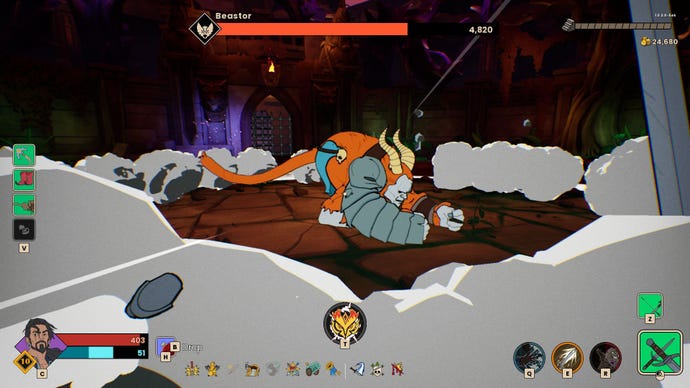
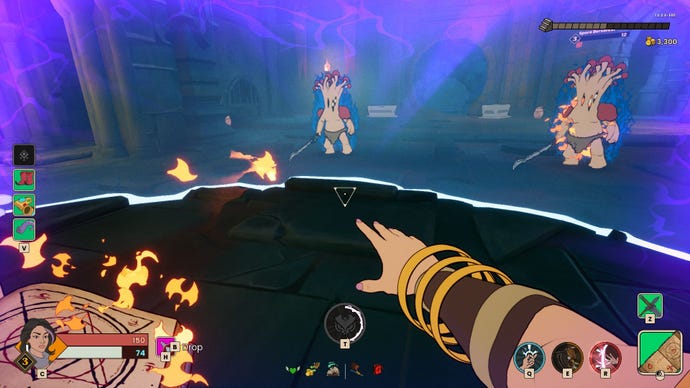

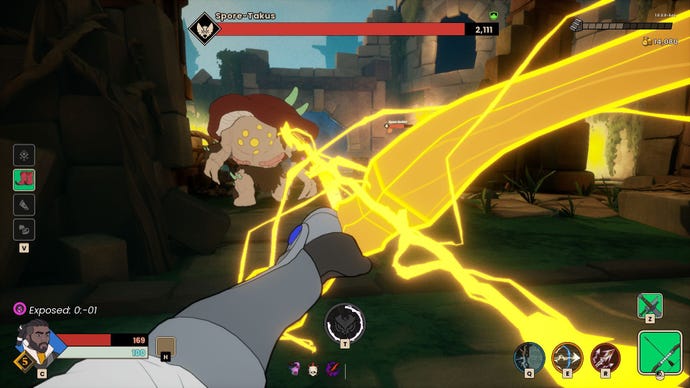
It feels hesitant to put something of its own into the genre, even though it feels perfectly capable.
In other words, it’s grand. But it could use a bit more pizazz of its own. Mythforce follows a template that has been long-defined and it feels hesitant to put something of its own into the genre, even though it feels perfectly capable. The combat is at its best when something unexpected happens. Mushroom enemies who suddenly shrink to dodge your arrow. Treasure pots that come to life when you take a swing at them and then roll around spreading sticky goo that slows everyone down, ally and enemy alike. Or my personal favourite: the toddler-sized goblins who rub their hands together like little green fuccbois, then steal the magic boots right off your feet and run away with them. I love a fucked-up little guy in video games, so the liberal use of miniature tricksters in Mythforce pleases me.
What’s less pleasing is some of the melee combat. The strict tracking of enemy area attacks, for example, feels a bit odd. And there’s a very leisurely delay between a big glowing warning ward appearing on the ground, and the magical attack itself landing. Your reactions may vary but for me these attacks somehow work against instincts I’ve long honed with the dodge rolls and side steps of similar games. There’s also some sluggishness to enemy animations, and inconsistency when it comes to the warning flashes that appear to show you can parry an attack. It’s hard to tell precisely what’s off in this regard, but there’s definitely something tripping me up (I swear I’ve swung a mace before, honest). In short, the parry mechanic is a little too hard to read to make it truly satisfying. I always ended up favouring ranged attacks offered by bows and magical tomes.
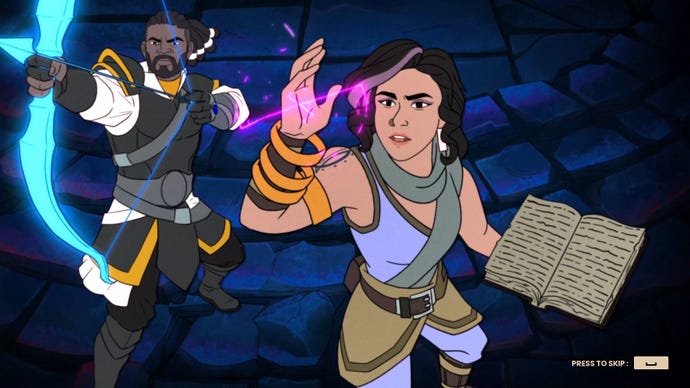
Outside of the first-person dungeon struggle, there’s a bunch of progression menus that make sure your character is always getting a little stronger between runs. Even a failed run nets you some gold to pump into making perks and items stronger. There are also gleaming gems that let you permanently increase character stats, lessening ability cooldowns and bulking up default attack power and so on. Again, this is by-the-book rogueliking, the classic incremental character improvement over many runs. It’s hard to get excited about, but at least you know the piecemeal improvement is there when things go wrong and you stumble into a fire trap like a big dumb pig helpfully barbecuing itself.
In the downtime that follows, the menus turn out to be fairly unintuitive. I almost didn’t even notice the background buildings on the lobby screen are actually clickable, leading to the shops and upgrade menus. And when you do fumble into them there’s a lot of repeated information obscuring what you actually need to know about an item’s in-game magical effects. In one owlman’s shop every item says “Dropped in-game” (yes, I know, where else would it appear?) and then the item’s effect, then “Minimum drop rarity of common/rare/etc”. Only one of these sentences is really needed – the item’s effect. This is the word butcher in me talking. It doesn’t kill the game, obviously, I’m nitpicking. But some more tidiness under the roguehood goes a long rogueway.
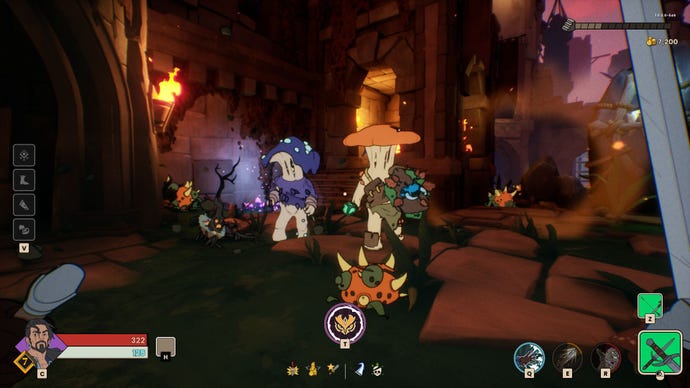
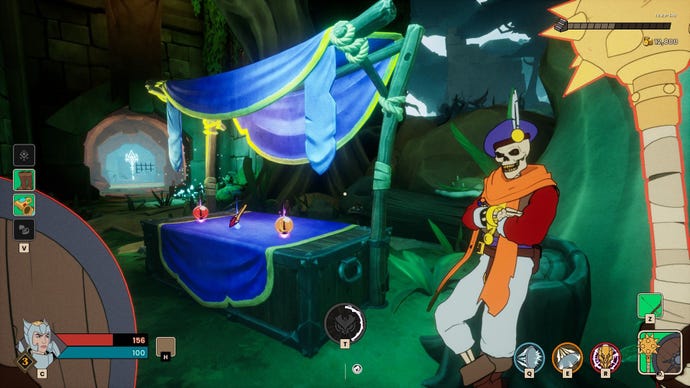
All in all, I haven’t been blown away by Mythforce. I was expecting something a little funnier and self-deprecatingly daft. But it isn’t a badly crafted boney boy basher. A single solo run often left me murderizing for a happily thoughtless 30-45 minutes. That’s likely to be shorter if you play with the friends I don’t have, and embrace the hectic “kill stuff, get buff” attitude that comes from any reliable multiplayer game that is secretly just an excuse to chat. In this sense, Mythforce is less “Saturday morning cartoon” and more “Sunday evening co-op”. It might not have the staying power or variety of others in the genre, but if greedy goblins and low stakes are enough to goad you into a weekend or two of battering baddies with buds, then go for it. I believe in you!
This review is based on a review build of the game provided by publishers Aspyr.
